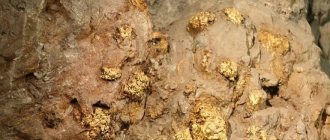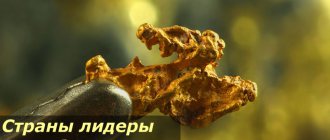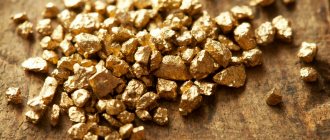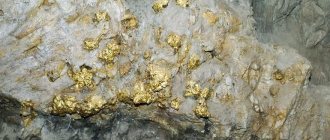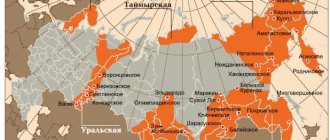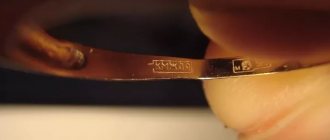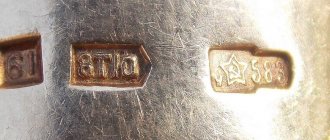The Ural region is rich in many different minerals. Gold is also found here, which is mainly found in deep mines. There are small and large deposits of the precious metal in the region. Gold mining in the Urals using artisanal methods, according to maps, has been going on for more than one century. The oldest deposit of this metal is hidden in the local mountains. Today, both large companies and private miners are looking for aurum.
Place of Birth
The high popularity of gold mining in the Urals is due to many factors. This region attracts prospectors for the following reasons:
- moderate climatic conditions allowing the extraction of gold-bearing veins within several months;
- absence of permafrost layers, which create additional problems during ore mining;
- successful gold deposits in terms of geographical location.
Gold mining in the Urals is carried out in several ways:
- Handmade or artisanal. Basically, prospectors use the gold-bearing rivers of the Urals to extract metal.
- Ore. Extraction is carried out in mines.
- Use of dredge. In this case, the rivers of the Urals are also used.
- Hydraulic.
Due to the fact that this region contains rich deposits, the ore method is used to extract metal. Examples of local ore deposits are summarized in the table below. This is a kind of map that indicates where to look for gold in the Urals.
| Type of deposit | Peculiarities | Examples of deposits |
| Indigenous | Vein and mineralized zones occur in the Urals. | Koncharskoye, Svetlinskoye, Kurosan (southern and western), Nailinskoye |
| Placers | They are a gold-bearing mass that has accumulated in one place through the transfer of ore and rock by water. | Bolsheshaldinskaya placer, Moss swamp. |
According to experts, up to 15% of the world's gold reserves are hidden in the Ural region. Analysts predict that if current production volumes are maintained, the precious metal will last for about 100 years.
The Urals are one of the richest sources of minerals. The region contains many deposits of precious metals, which are mined by both manual and industrial methods.
Gold dredge
After many years, the technologies used to mine gold in ancient times have not changed much. All that has changed is the work of mechanized machines instead of human labor.
Today, few people are engaged in gold mining using trays, since this method is no longer relevant and widespread. But the technology has survived. Today, many people use a huge machine that has a large number of trays.
A dredge is a device used to flush water from a river. It is this huge and noisy structure that is capable of extracting precious metal from river rock. Although this method is very effective and profitable, it has a very negative impact on the environment. After dredging, river beds are left in a deplorable state. But in order to know how to find and then safely extract gold from the river, it is recommended to use dredging as the easiest way to mine gold.
Primary deposits
In the Urals, gold is mined from the following types of deposits:
- vein;
- mineralized, in which, in addition to gold-bearing veins, other inclusions are found.
The Ural vein deposits, depending on the composition and depth of occurrence, can be divided into:
- quartz (up to 15 meters);
- sulfide (located at a depth of up to 2 meters);
- easily enriched, when deposits of gold ore are located almost on the surface.
When mining gold in the Urals using the artisanal method, it is recommended to select maps that contain an indication of the location of quartz. This is explained by two reasons:
- Quartz is one of the most common minerals.
- It is often adjacent to gold-bearing rocks.
These minerals come in different colors. If the discovered quartz contains empty cavities, this will facilitate further search for gold.
The presence of such formations indicates that inclusions of noble metal were previously found in the mineral. Accordingly, it can be found if you excavate neighboring veins.
Quartz deposits are among the most attractive. The fact is that they contain so-called native gold with a minimal amount of foreign inclusions. Moreover, in most cases, the metal contains inclusions of silver.
On the territory of the Ural Mountains, which lie only in the Orenburg region, about 150 gold deposits have been discovered. Private prospectors can try their luck on rivers located near:
- Kirovsky (Kvarkensky district);
- Aydyrlinsky (not far from the village of the same name);
- Blakskoe deposits (Svetlinsky district).
In all these areas, the precious metal is mined industrially. In particular, near the village of Aydyrlinsky, gold lies at a depth of more than 100 meters. From the point of view of a private miner, the Ural rivers and local placers will be the most attractive for ore extraction.
Tsarevo-Alexandrovsky mine (Leninsk)
In 1824, Tsar Alexander I visited the Miass gold mines.
Not long before this, the richest mine on Tashkutarganka was called Tsarevo-Alexandrovsky, which, of course, was brought to the attention of His Imperial Majesty. Alexander I arrived, as he put it, “to his mine” on September 23. Here he wanted to “try” his luck
It was a clear September day in 1824. According to rumors, while they were waiting for the tsar, just before his arrival, Dementy Petrov, a simple man, dug out a nugget worth eight pounds from the “tsar’s” face, the same one that was later called the foundling. The find, on the one hand, gave hope that the emperor would also be lucky, but, on the other hand, Dementia’s nugget could have gone to the king if he had not gotten ahead of him. However, the nugget still ended up with Alexander - it was handed to him along with bread and salt when the king arrived on the shore of Tashkutarganka.
A king with a shovel in his hand at the bottom of a rather deep hole is not an ordinary picture. Yes, Alexander took a shovel - “I’m like a Bergauer” - and began to dig into the clay. The others also grabbed shovels and began to pick at random, glancing sideways at the monarch. Having loaded several boxes, which were immediately raised up, Alexander put down the shovel, took hold of the pick, stuck it into the sand and hit some stone. They helped him turn it out, and Alexander rose to the surface with a stone in his hands. He was greeted with applause. “Am I really that happy?” - he was surprised, hoping that he had a nugget in his hands.
Then, in front of the king’s eyes, 22 pounds of ore mined by him were washed. They contained 12 spools, which the sovereign prospector took as a souvenir, along with Petrov’s nugget and a piece of ore he dug up. Having distributed gifts to everyone - money to Petrov and other workers, an order to the head of the Zlatoust mining plants Tatarinov, Alexander left “his” mine. I shouldn't have rushed. Because on the same day, in the same face, a nugget weighing more than eleven kilograms was recovered. And for another two weeks we came across nuggets - some worth three, some worth five, some worth all of 10 kilograms. There were a dozen of them in total.
Riot at the mine
This was shortly after Tsar Alexander I arrived at the Miass gold mines at the Tsarevo-Alexandrovsky mine.
At the mine in those days, the cruel man Shlykin was the caretaker.
The workers feared him like fire, but they were also angry with him, therefore this Shlykin killed a lot of people, and through his fault many people perished under the executioner’s lashes and in eternal hard labor.
Then workers were driven from everywhere to the gold mines and they were called exiles, and there were also many runaway convict soldiers, these were shackled in chains. There were burnt brands on the shackled men's foreheads, their ears were torn and their nostrils were also torn.
In the summer, the workers lived near the mines, in the open air, and in the winter in sheds-barracks on Kaskin, two miles from the mine - there was a mine office and the owner's industrial warehouses. They will lock the workers in the barracks, put a bucket, and a sentry at the door, outside. Like in prison.
The food was: cabbage soup, a pound of bread and boiling water. The workers lived poorly. They didn’t wash in the bathhouse for months at a time, but worked all day long from morning to evening. At that time they didn’t go into the mines; the treasury had enough gold at the top of the earth. The tools were: a pick, a shovel, a jello-mix and a wooden pump.
We had to work knee-deep in water, in low places. Here people died like flies, because, barefoot, in flimsy clothes, they caught colds, got sick and died, there was no help. There were no doctors or medicine in sight.
This time a field supervisor was on his way, and the workers were just having lunch right there near the washes. They sit around large wooden buckets and slurp bread. And just the counter-Tatar broke a piece of bread, and there was a baked mouse in it. The Tatar, of course, is also a man and does not eat mice. The hubbub rose.
At that time there were Vyatka men who worked at the mine under a contract. It was painfully difficult after the village to work in the fields. Shlykiya drove up to the workers and shouted: “What’s that noise?” Be silent! - How often is this? Feed the mice! We, tea, are not cattle! They were hiring - they said something, but now they say something else! We are not convicts, we will not torture mice.
And everyone surrounded the caretaker, and the Tatar thrust him a piece of bread with a mouse tail sticking out of it. The caretaker doesn’t want to know anything, he shouts his own: “What are you yelling about!” Throw away the mouse and eat! And the Tatar said: “I don’t want to go crazy!” Ashai yourself! He threw the bread at the feet of the caretaker’s horse: “Here’s your bread!” Mine is not a convict. Neat! I won't be shy.
The Vyatka Tatars supported him. “Record everyone!” the caretaker ordered the foreman. “And in the evening, if they don’t work, report to me!” He spurred his horse and rode off.
This party of workers started work, because it was a small group, and then there were armed soldiers and Cossacks with whips. The Cossacks whipped one or two with their whips, the soldiers hit them in the back with their rifle butts—you’ll have to work against your will.
Shlykin drove on, furious, not himself. And then he happened to see a red spot in one group of workers washing. I came closer, and this was a red shirt on a young guy. In those days, God forbid, if the bosses saw someone wearing a factory-made garment, it meant that the gold had been stolen by a worker, no less. Therefore, the earnings were barely enough for the worker to eat, and even if there were pennies left, you couldn’t get a red shirt for them. The guy's caretaker ordered him to be flogged. “He will know how to make red shirts with stolen gold.” The old father stood up for his son: “Have mercy,” he says, “your honor!” My shirt is already faded, my guy doesn’t drink, so he saved up for a shirt. Young, eager to go for a walk. It would be better not to say. My son and I were beaten at the same time.
And the next morning, five hundred Vyatka men and several shackles refused to work. Vyatsky’s: “Give us your passports!” Let's go home! And the shackles said: “I’m going to die anyway!” Let's not work! Bring on the manager! - A! Won't you? Okay! - and the caretaker ordered the Cossacks and officers to take the rebels named Bushmakov, Kondratyev, Yagomat Valiev and Kurochkin.
But the workers did not give it. They moved towards the guard and the officers and the caretaker, like an avalanche. They barely managed to reach the chapel—a monument in honor of Alexander’s arrival—and locked themselves up. But Shlykin realized what was going on earlier and sent a messenger to Miass with a report.
Only in the evening a hundred Cossacks rode up from Miass, and Bushmakov, Kondratyev, Yagomat and Kurochkin were taken and locked up. The workers refused to work - and they were also crowded, and the winter barracks on Kaskin were locked up and sentries were posted.
The workers held out for three days and did not go to work. On the fourth day, the governor and the mountain manager arrive from Zlatoust to the mine. First of all, of course, we talked to the caretaker Shlykin, the high authorities. And their conversation was like this: “To prevent others from doing so, flog the leaders!” Without any investigation, the governor wrote an order in the office: “For inciting a riot, run the leaders through the gauntlet...”
They took the workers out of the barracks and the governor came out with the manager. -What are you complaining about? Why are you lying idle? - We were deceived, your Excellency! Starved! We want to go home! “Give me the food you feed the workers!” the governor commanded. And there was meat cabbage soup, porridge and bread: the caretaker ordered it to be cooked perfectly this time. The governor tried the cabbage soup and barked: “Whip the instigators!” The workers moved forward, shouting: “This is a deception!” We will reach the king! The governor and the manager jumped into the carriage and off to Miass.
The next day, in a clearing near Kaskin, they lined up all the workers and led them in a circle through the line of leaders along the “green street.” Bushmakov, a Vyatka, hot-tempered man, was the first to pass through and received a hundred blows of the rod to the beat of drums. Kondratyev was a boy of about eighteen years old, he fell, they poured water on him and beat him again. Kurochkin Akim was a sick shackle, he fled from the Zlatoust plant. His throat was bleeding. He was beaten to death. Yagomat, a healthy Bashkir, when he walked down the “street”, shouted: “I still won’t work!” His Bashkirian comrades answered him from the ranks: “We won’t!” Be patient, Yagomat! Well, they beat Yagomat very hard - almost to death. And the body of Akim Kurochkin was buried by the Cossacks in the bushes near Kaskin. The workers had to get to work.
Soon Bushmakov, Yagomat and Kondratyev fled with the daughter of Akim Kurochkin from the mine. They were overtaken by the Cossacks in the Ilmen Mountains, beyond Miass. Bushmakov, Yagomat were shot, and Kondratyev and Aksyutka fled to an unknown destination.
Secret tales of the workers of the Urals, 1941
Placers
Gold placers in the Urals are located in areas located:
- near Magnitogorsk and Tagil;
- on the eastern part of the mountain range;
- in the central part of the Urals.
The upper reaches of the Suunduk River deserve special attention. It flows along the Ural mountains through the territory of the Orenburg region. At the same time, the upper layers of local placers have long been worked out. Currently, the development of layers that lie deep underground is underway.
Mostly alluvial placers are found here. They are formed due to the gradual transfer of rock mass, which includes gold veins. Such placers are often located in river valleys. In such deposits the gold is well rounded. That is, the metal is presented in the form of grains with clear edges.
Gold-bearing layers in the territory of the Ural placers are often concentrated in a certain zone. The maximum length of such deposits reaches 5 kilometers. Precious metal in local placers usually lies at a depth of 10 meters. There are also upper layers (1-3 meters) and deep layers (up to 60 meters).
The concentration of gold in placers varies. It varies from 0.01 to several milligrams in each cubic meter of mined ore material. Whole nuggets are also found in the Ural Mountains.
The attractiveness of local placers, from the point of view of private miners, is due to several factors. Firstly, there are more than one hundred of these deposits in the Urals. Secondly, they are formed by erosion of rock, due to which gold-bearing layers are formed on the river bottom. You can also look for metal in the area of the old riverbed. In other words, in the area where the river used to flow.
Placers in the Urals are a rich source of gold. Such deposits are found in various areas of the Siberian mountains, both close to populated areas and at a considerable distance from them.
Pervomaisky village and ancient mine
If you drive a little further along the road, the small village of Pervomaisky begins. At the entrance to it, the so-called “author’s” village “Severnaya Sloboda” is being built.
, the Mostovsky gold mine arose here . Residents were engaged in artisanal fishing. Thus, a new settlement gradually grew, which later received the name Pervomaisky. The Pervomaisky Klyuch river flows through it.
In 1877, a chapel was built here. In 1881, it was rebuilt into a single-altar wooden church , consecrated in the name of St. Nicholas the Wonderworker. It is interesting that the iconostasis for her was purchased from the church in the village of Gornoshchitsky. In 1885, a parish school was opened in the village. In 1930, the church was closed and the dome and bell tower were demolished. The building was given over to the club, thanks to which it has survived to this day. According to the 2010 census, only 68 people lived in the village of Pervomaisky.
In the forest, about a hundred meters east of the outskirts of the village, you can see an ancient mine. There are several small quarries and pits here. The site is noted on Wikimapia as a chromite mine .
Where to search
As an example of the Ural placers, two of them can be cited:
- Bolsheshaldinskaya;
- Moss swamp.
The Bolsheshaldinskaya placer has been mined for about two centuries. According to research conducted by a Soviet geologist, this deposit is located near primary sources. At the Bolsheshaldinskaya placer there are both small inclusions of gold-bearing mass and whole nuggets. Moreover, the first ones occur most often.
Alluvium (rolled) materials are hidden in the local area under clay and a black marshy layer. Almost all sediments here contain gold. The exception is floodplains.
The following minerals are found at the Bolsheshaldinskaya placer:
- magnetite;
- titanite;
- pyrite;
- monazite;
- rutile and others.
If for some reason a prospector was unable to find a map of the Ural deposits, these minerals will make the search for gold-bearing layers easier. The precious metal that the Bolsheshaldinskaya placer contains is one of the purest. It contains only silver in small concentrations.
The moss swamp is located in the Southern Urals, in the Chelyabinsk region. There are also primary deposits with a high content of quartz and sulfide. According to the results of the surveys, for every ton of rock collected in the Moss Swamp, there are up to 1-10 grams of gold and 10-13 (even 50-100 are detected) grams of silver.
Also, research data indicate that the precious metal is presented here in the form of intergrowths with quartz or individual nuggets. The largest “ingot” found in the Moss Swamp weighed 94 grams.
Both placers are rich sources of gold. They contain small and large inclusions of high-grade noble metal.
How gold is mined
In the Urals, traditional technologies are used for gold mining using:
- Industrial device. It is not recommended to use industrial equipment for gold mining in the Ural Mountains. The fact is that such an installation traps fairly large particles of metal. However, in local placers, the material is often either included in other minerals or has very small sizes. In addition, Ural gold is hidden under a layer of clay and heavy soil. In Soviet times, devices were used at local deposits that could capture particles ranging in size from 0.5 to 80 mm. Moreover, even the use of such equipment did not exclude numerous losses. According to researchers, industrial devices released up to 15-40% of the gold mass back into the soil. And particles no larger than 0.25 mm in size were not recovered at all. Experts believe that with minimal investments and the organization of small enterprises, up to 7 tons of gold can be extracted annually from already developed Ural deposits.
- Minidrag. Minidrags are autonomous installations through which river sands are washed in order to extract gold particles from them. These devices include pumps that supply the material. Mini dredges are used in various placers and flooded areas where gold-bearing masses may potentially occur.
- Minigates. Mini-sluices have a design similar to mini-drags. The difference in the design of both devices is that the latter are mounted on pontoons. Mini-gates are installed on the banks of gold-bearing rivers. These devices, through a flexible hose, suck in sand, which is fed to a hydraulic screen, where the material is initially purified from impurities. Mini-sluices are also used in dry areas containing gold-bearing strata.
- Metal detector. Another device that private miners use in their work. Depending on the characteristics of the metal detector, it is capable of detecting gold inclusions in the soil layer at a depth of up to 50 cm. Some devices are equipped with a disintegrator that determines the type of mineral rock.
Novice miners also use special trays for washing gold-bearing sand in rivers.
Recommendations for working with a metal detector
If in the case of mini-dredges and mini-sluices it is initially clear how to choose a place for future mining, then when working with a metal detector it is recommended to go to the territory where nuggets weighing more than 50 grams were previously found. This device simply will not detect small gold particles. You can find out in which region relatively large nuggets were previously discovered from geologists or at the local library.
Quite often, large particles of gold are localized in a separate area, forming so-called nodes. Accordingly, once found, a nugget will most likely lead to other large-sized precious metals. It is important to understand that in most cases such deposits have been previously mined. However, during mining, some of the minerals often remain in the ground.
The search for gold-bearing masses in the Urals is carried out on:
- new areas;
- technogenic (spent) placers.
The most preferable search is in new areas. It should be noted that work in such territories often leads to unsatisfactory results. On the other hand, there is a possibility that a small gold mine may be discovered. In addition, there are many unexplored areas in the Urals that could potentially hide precious metals.
Working on technogenic placers is suitable for those who, first of all, want to extract gold. Such areas always contain several grams of precious metal. However, a prospector in technogenic placers will not be able to extract gold in significant quantities.
Historical reference
The Urals is the place where gold was discovered for the first time in Russia and the first mine started working. Unsuccessful searches for gold had been undertaken before, but only in 1745 Erofei Markov found a strange stone with gold inclusions and went with it to Yekaterinburg. He almost paid with his life for his discovery, since mining engineers did not find the precious metal at the place he indicated and suspected him of lying. However, Lomonosov's student, Ignatius Yudin, discovered particles of gold in the ore and in 1747 the first mine of the Berezovsky mine was founded.
Thus, Russia not only acquired its own gold, but also became the only state in the world where the extraction of precious metals begins not from alluvial deposits, but from ore deposits. However, the mine did not immediately begin to bear tangible fruits - the first data on the mined 16 pounds of gold are dated 1754.
First major finds
Exploration for gold deposits continued and by the end of the 18th century, about 140 gold-bearing veins had been identified and dozens of mines had been built. On one of them, in 1842, the largest Russian nugget was found, called the “Big Triangle,” weighing more than 32 kilograms.
But the real gold rush begins with the discovery of deposits of placer gold, which experienced prospector Lev Brusnitsyn purposefully searched for and found on the banks of the Berezovka River.
Not only did he discover a deposit with an easy and inexpensive manual mining method, but he also developed a soil-washing device known as a borehole, or "American", which was subsequently widely used in the mines of California and Alaska.
Search in waste placers
When choosing an area of technogenic placers to search for gold-bearing veins, it is recommended to pay attention to areas located near the headwaters of rivers. This is explained by the fact that large particles of precious metal are poorly transported by water flows. Therefore, they accumulate near the gold-bearing vein. In the lower reaches, mostly small gold is found.
Individual nuggets may be found in these areas. But discovering such zones seems to be a rather difficult task, requiring patience and luck from the prospector. Beginner gold miners are advised not to go further than 2 km from the source of the river.
When searching, you should pay attention to areas where bedrock is exposed. It is best to mine the material immediately after industrial mining has ended at the site. This is explained by the fact that even with highly efficient equipment and complete clearing of the territory, there remain cavities that have preserved gold.
So, when searching for precious metal in technogenic placers, you should select areas:
- where commercial production has recently completed;
- they are located in the upper reaches of rivers;
- deposits include relatively large gold.
In cases where the carpenter is completely closed, you can use a metal detector to look for gold in sand dumps. Quite often in such formations, nuggets are found together with quartz.
Working with dumps is more difficult. They contain a lot of small metal debris.
